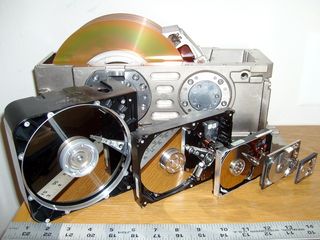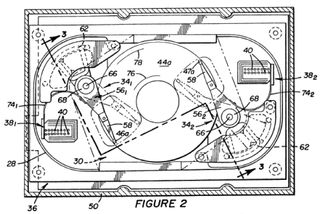Exclusive: The Dual Actuator/Head Hard Drive

Last week we reported about Seagate's latest Cheetah 15K.7, which is the company's latest enterprise level HDD, boasting a blistering spindle speed of 15,000 RPM and a decent capacity of 600 GB.

While talking about the drive, one commenter proposed a question: why don't hard drive manufacturers do something like add a second set of read/write heads to increase performance rather than turning up the spindle rate to dangerously high levels?
Good question! We went directly to Seagate for the answers.
A long time ago, there was a company called Conner Peripherals. Some Tom's Hardware readers may remember the company. Conner actually patented a hard drive design that utilized dual actuators, that is, a hard drive with two sets of read/write units. Later on when Seagate acquired Conner, the intellectual property transferred to Seagate.
Seagate's first drive with multiple read/write heads was actually a 10 MB drive. But instead of using two sets of actuators, each arm actually two read/write heads--one at the end, and one on the middle. The drive had two arms, one above and one below the platter, giving the single platter drive four read/write heads. The arm actually moved forward and backwards in a straight line--like today's optical drives--using a stepping servo instead of in a curved sweeping motion. One read/write head would be responsible for the inner half of the platter while the second read/write head would take care of the rest.

The 10 MB drive had a single platter with a track density of 550 tracks per inch. Each track being a full ring around the platter. (Right Photo: The 10 MB Seagate ST-412)
After one drive however, Seagate developed a 2 GB drive with dual actuators. The drive had an actuator mechanism at opposing corners which theoretically provided double the throughput and operated independently of each other. The drive had an RPM rate of 7200 RPM and had a track density of 3000 tracks per inch.
Stay on the Cutting Edge
Join the experts who read Tom's Hardware for the inside track on enthusiast PC tech news — and have for over 25 years. We'll send breaking news and in-depth reviews of CPUs, GPUs, AI, maker hardware and more straight to your inbox.
For comparison sake, the new Cheetah 15K.7 has a track density of 165,000 tracks per inch and Seagate's latest 2 TB drive has 236,000 tracks per inch.
As drive capacities continued to increase however, Seagate stopped producing dual-actuator drives for several reasons:

First and most importantly, it's cost prohibitive to produce such drives. When you factor in the extra components, increased material usage, and weight gains, the advantages are minimal said Seagate. Secondly, dual-actuator drives will be larger, produce more heat, and consume more power. Lastly and probably most important, is that current harddrives store detailed servo detail about the physical makeup of the platters. Due to fluctuations in heat, materials expand and contract differently at different locations on the disk. All this would have to be taken into account with a dual-actuator drive. Consequently, one actuator would actually perform differently than the other. In terms of logic, there would have to be two head controllers, or at least a controller that was capable of handling two actuators.
According to Seagate, such a drive would weigh approximately 20-percent heavier and take up more room in terms of length.
So while creating a dual-actuator drive today is technically possible, it's not a viable business solution.
Seagate also mentioned to us that decades ago when harddrives were too heavy to even lift, many drives actually had sweep-heads--literally. These heads had camel-hair brushes on them that would sweep the platters clean as they turn. Such drives were utilized in large-scale mainframe systems.
Will manufacturers like Seagate ever bring back hard drives with dual actuator heads? Unlikely, given that the focus is now on increasing capacities and SSDs.
Below we have photos of the original patent that Conner Peripherals filed for its dual-actuator hard drive technology:












Many thanks go to Seagate for its help on this article.
-
maigo But really, who wants a 15,000rpm velociraptor to be turbo charged to a 'simulated' 30,000rpm? Format was already changed making the velociraptor, they could easily cram in another arm without making the drive longer than standardReply -
puddleglum Because today instead of a Dual Actuator/Head setup, we use two HDDs in a RAID setup. :)Reply -
nekatreven So we just have to ask and the answer will be revealed?!?Reply
"Why do hotdog buns come in packs of 8 when hotdogs come in packs of 12?"
(but really, nice article) :) -
joex444 That first Seagate implementation isn't even what comes to mind. What I mean, is if you have one read head that does half the platter, and another for the other half then you can only increase the transfer speed if your data is completely randomly scattered. This would not help sequential reads whatsoever.Reply
Now who would want to run a 5.25" HDD? Maybe stick two sets of platters from 2.5" drives in there and see what happens. Technically its dual actuator... Implement a RAID controller onboard and see what happens. -
nirvanabah nekatrevenSo we just have to ask and the answer will be revealed?!?"Why do hotdog buns come in packs of 8 when hotdogs come in packs of 12?"Reply
To force OCD people to buy 2 packs of hot dogs and 3 packs of buns whenever they want a hotdog, duh! -
daneault nekatreven"Why do hotdog buns come in packs of 8 when hotdogs come in packs of 12?"(but really, nice article)Reply
Not to derail the thread further, but the hotdog buns come in packs of 6 or 12 where i come from (QC, Canada).
Nice article. -
hemelskonijn Make up your mind!Reply
Last week we reported about Seagate's latest Cheetah 15K.7, which is the company's latest enterprise level HDD, boasting a blistering spindle speed of 15,000 RPM and a decent capacity of 600 GB.
The spec's say 15.700rpm and as any one can see so way the model indication why do you guys at toms keep calling it a 15,000rpm drive ? -
I have another question. Why don't all heads read in parallel?. That would not reduce rotational delay but it could increase throughput.Reply
Most Popular

